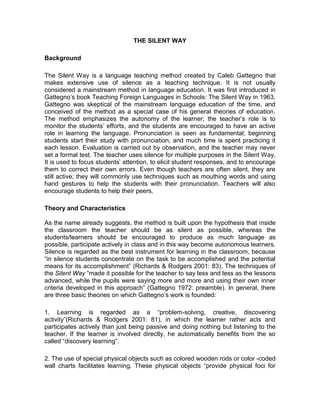
El metodo silencioso
- 1. THE SILENT WAY Background The Silent Way is a language teaching method created by Caleb Gattegno that makes extensive use of silence as a teaching technique. It is not usually considered a mainstream method in language education. It was first introduced in Gattegno’s book Teaching Foreign Languages in Schools: The Silent Way in 1963. Gattegno was skeptical of the mainstream language education of the time, and conceived of the method as a special case of his general theories of education. The method emphasizes the autonomy of the learner; the teacher’s role is to monitor the students’ efforts, and the students are encouraged to have an active role in learning the language. Pronunciation is seen as fundamental; beginning students start their study with pronunciation, and much time is spent practicing it each lesson. Evaluation is carried out by observation, and the teacher may never set a formal test. The teacher uses silence for multiple purposes in the Silent Way. It is used to focus students’ attention, to elicit student responses, and to encourage them to correct their own errors. Even though teachers are often silent, they are still active; they will commonly use techniques such as mouthing words and using hand gestures to help the students with their pronunciation. Teachers will also encourage students to help their peers. Theory and Characteristics As the name already suggests, the method is built upon the hypothesis that inside the classroom the teacher should be as silent as possible, whereas the students/learners should be encouraged to produce as much language as possible, participate actively in class and in this way become autonomous learners. Silence is regarded as the best instrument for learning in the classroom, because “in silence students concentrate on the task to be accomplished and the potential means for its accomplishment” (Richards & Rodgers 2001: 83). The techniques of the Silent Way “made it possible for the teacher to say less and less as the lessons advanced, while the pupils were saying more and more and using their own inner criteria developed in this approach” (Gattegno 1972: preamble). In general, there are three basic theories on which Gattegno’s work is founded: 1. Learning is regarded as a “problem-solving, creative, discovering activity”(Richards & Rodgers 2001: 81), in which the learner rather acts and participates actively than just being passive and doing nothing but listening to the teacher. If the learner is involved directly, he automatically benefits from the so called “discovery learning”. 2. The use of special physical objects such as colored wooden rods or color -coded wall charts facilitates learning. These physical objects “provide physical foci for
- 2. student learning and also create memorable images to facilitate student recall” (Richards & Rodgers 2001: 81). 3. Learning is facilitated by involving the learners and letting them solve problems on their own with the help of the provided materials TEACHER and LEARNER ROLES Teacher Roles-. The Silent Way is not a teacher- centred approach. While the teacher uses mainly gestures and facial expressions to address the learners, his/her main task is the teaching of the language by letting the students test out grammatical forms, etc. and getting out of their way, so that they can discover these things on their own. Learner Roles: The learners are expected to participate in class actively. They should be willing to make mistakes, to test out the basic language elements via the usage of the materials provided and generally be highly motivated. As a learner, it is important not to get frustrated in case the Silent Way lesson sometimes may be a little tricky and the meaning of the materials is not always clear at first sight. Therefore, it is important to be able and willing to think in a rather abstract way so that the meaning of the provided material can be detected. ADVANTAGES AND DISADVANTAGES Advantage: The use of the Silent Way enables a very high degree of interaction as well between the teacher and the students as between the students themselves and additionally raises the participation of the students in class. The self-esteem of the students will be increased and this will enhance learning. Disadvantage: The Silent Way is a very abstract way of learning a language, the learners have to engage themselves with the artificiality of the approach, which is extremely different from more commonly used methods of language learning. - This method can be benefited by the teacher only in small groups of students. The teacher can gain ability in this method by trying. The teacher is expected to enrich the materials on his/her own. - For some learners, one limitation is the approach to language basics which begins with seemingly irrelevant discussions about rods and which involves silence and concentration and games with the teacher about meaning. Students’ expectations and need for immediately relevant language learning may force teachers to abandon the approach (Celce-Murcia 1979).
